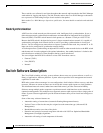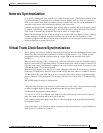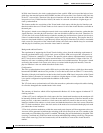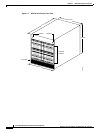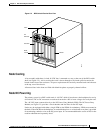
1-40
Cisco BPX 8600 Series Installation and Configuration
Release 9.3.10, Part Number 78-11603-01 Rev. D0, July 2001
Chapter 1 The BPX Switch: Functional Overview
Virtual Trunk Clock Source Synchronization
In Wide Area Networks, the clock synchronization from a public ATM service provider helps to have
glitch free, data transfer between the IGX/BPX and the service provider, if we can derive the clock out
of the VT’s successfully. Therefore if the physical interface can derive the clock from the ATM cloud,
irrespective of any Virtual Interface failures, the nodes in a network can achieve a higher degree of
clock synchronization.
This feature enables the association of the Virtual trunk clock source with the physical interface and
therefore enables the use of Virtual Trunks as clock sources for all of the virtual interfaces available on
the trunk port.
This project is aimed at associating the network clock source with the physical interface, rather than the
virtual interface, since the physical interface is the one which drives/derives the clock. Therefore, if a
VT fails, the clock source should not be switched to another physical interface or internal clock source,
if there is another healthy (clock configurable) active interface up and running. This implies that if at
least one virtual trunk interface is upwithout any failure, the physical interface will still be a sustainable
clock source. So irrespective of the virtual trunk failure, the clock source should always be associated
with the physical interface port, where the virtual trunk is activated.
Background and Justification
The requirement of supporting the Virtual Trunk clocking, arises from the marketing requirement of
network synchronization using a single clock source of public ATM service provider, irrespective of
single VT failures in a multiple VT scenario. The present switch software implementation associates
the VT clock source with the first logical trunk interface (VI), and therefore a failure of the first VT
interface, will cause a switching of the clock source to the next available interface. This project is aimed
at allowing the network clock source to be always associated with the physical interface, since the
physical interface is the one which drives/derives the clock.
Configuration
The clock synchronization from a public ATM service provider helps to have a glitch free, data transfer
between the IGX/BPX and the service provider, if we can derive the clock out of the VT’s successfully.
Therefore, if the physical interface can derive the clock from the ATM cloud, irrespective of the Virtual
Interface failures, the nodes in a network can achieve a higher degree of clock synchronization. There
is no special configuration required with the addition of this feature
Overview
The VT clock source synchronization will allow the network to synchronize and provide stable clocking
for all nodes throughout the attached nodes in the cloud.
The summary of functions which will be implemented in Release 9.3 for the support of enhanced VT
clocking includes:
1. When a VT port is configured for clock source, the first virtual trunk interface on the trunk port will
be internally marked as the clock source. Unlike the current implementation, if the first interface on the
trunk port fails, or becomes unusable as clock source, the node will search for the next active virtual
interface (which will be usable as a clock source) and mark that interface as the clock source. Therefore
this VT search mechanism, allows the clock source of the node to be associated with the physical trunk
port rather than virtual interface.
2. The clock selection mechanism, within the same trunk port(slot.port) will be transparent to the user.
An event will be generated to indicate the switching of the clock source from one VI to another on the
same trunk port, if the debug flag on/off3 is enabled. This debug flag will be defaulted to ‘disabled’.This
event log is confined only to the local node and can be enabled through a debug on/off flag. The present
clock switch event logs (local and remote node) will be modified, to remove the virtual interface
number.





